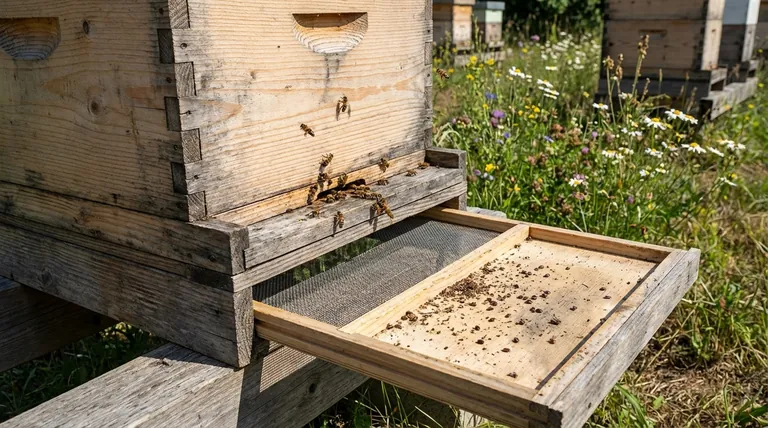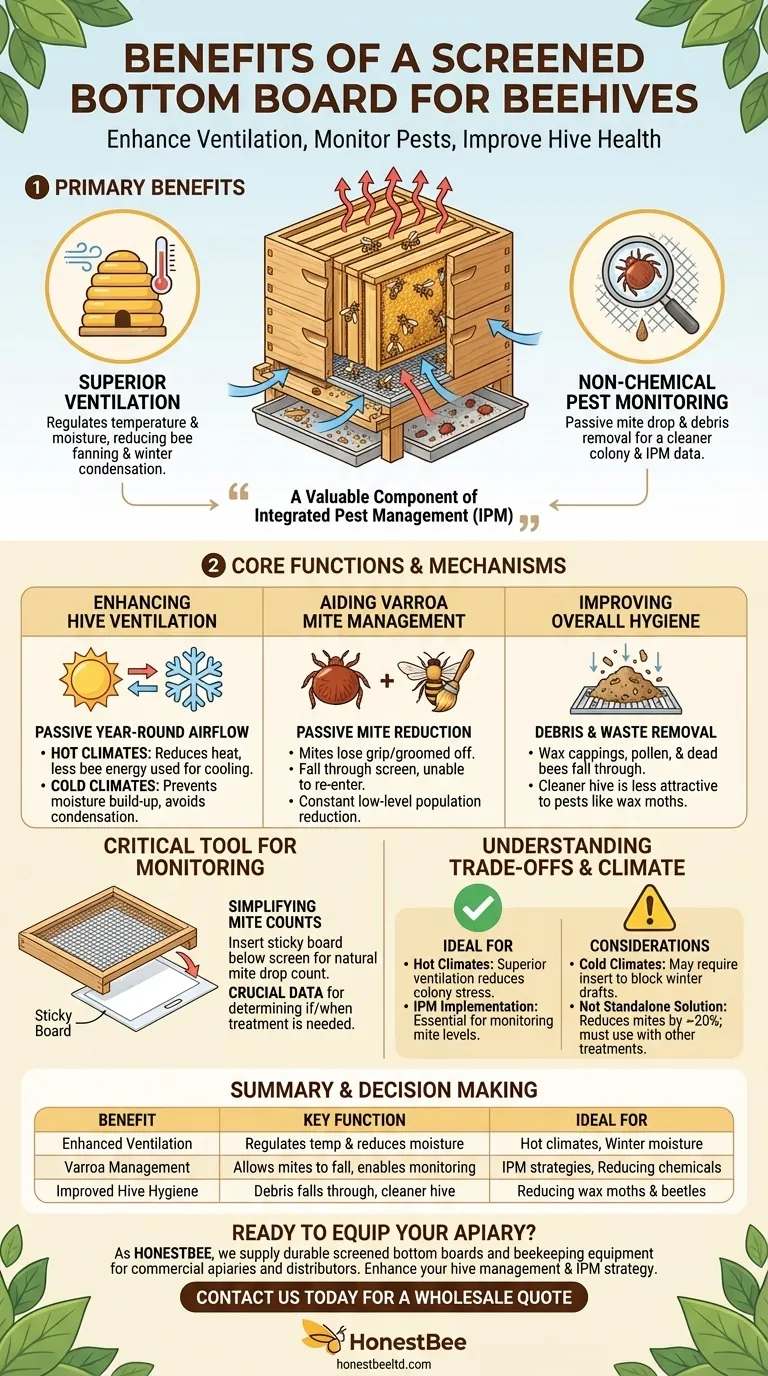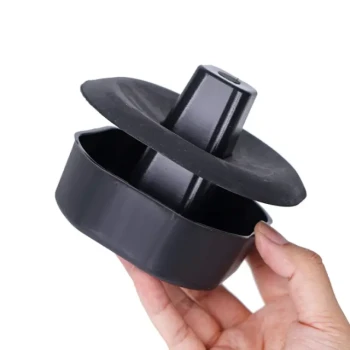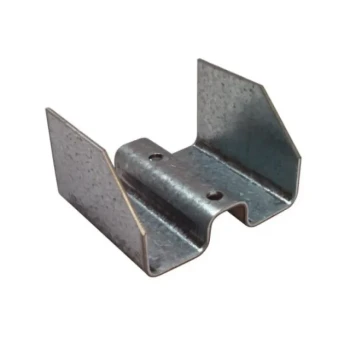The primary benefits of a screened bottom board are superior hive ventilation and a non-chemical method for monitoring and reducing Varroa mite populations. This design improves airflow to regulate temperature and moisture while allowing mites and debris to fall harmlessly out of the hive, contributing to a cleaner and healthier colony.
A screened bottom board is best understood not as a standalone solution, but as a valuable component within an Integrated Pest Management (IPM) strategy. Its true strength lies in enhancing hive conditions and providing critical data about pest levels.

The Core Functions of a Screened Bottom Board
A screened bottom board replaces the traditional solid wood base of a hive with a durable, correctly-sized wire screen. This simple change has a significant impact on the internal environment of the colony.
Enhancing Hive Ventilation
Proper airflow is critical to a colony's health. A screened bottom provides passive ventilation year-round.
In hot climates or during peak summer months, the screen allows excess heat to escape, reducing the energy bees must expend fanning to cool the hive.
During cool, damp winters, it allows moisture-laden air to exit. This helps prevent condensation from forming and dripping on the cluster, a major cause of winter colony loss.
Aiding in Varroa Mite Management
The Varroa destructor mite is a primary threat to honey bee health. Screened bottom boards were popularized as a tool to combat them.
When mites lose their grip or are groomed off by bees, they can fall through the screen and out of the hive. This prevents them from climbing back onto another bee.
This passive mite drop provides a constant, low-level reduction in the hive's overall mite population.
Improving Overall Hive Hygiene
A hive produces a surprising amount of debris, including wax cappings, pollen, and dead bees.
With a screened bottom, this debris falls through the screen instead of accumulating on the hive floor. A cleaner hive is less attractive to other pests like wax moths and small hive beetles.
A Key Tool for Monitoring Hive Health
Beyond its passive benefits, the screened bottom board is an active diagnostic tool for the attentive beekeeper.
Simplifying Mite Counts
The most effective way to use a screened bottom board for pest management is to monitor mite levels.
By inserting a white, sticky board (often called a "mite board" or "sticky board") underneath the screen for a set period, you can perform a natural mite drop count.
This data is crucial for determining if and when your colony requires more aggressive mite treatment, forming the cornerstone of an effective IPM plan.
Understanding the Trade-offs
While beneficial, screened bottom boards are not without their considerations. Objectively weighing the pros and cons is essential.
Climate Considerations
In regions with very cold winters, a fully open screen can create too much airflow. This may force the colony to consume more honey stores to generate the heat needed to keep the cluster warm.
Many beekeepers in colder climates use an insert to close off the screen during the harshest months, removing it in the spring.
Not a Standalone Mite Solution
It is critical to understand that a screened bottom board is not a complete Varroa mite treatment.
Studies suggest it may reduce the mite population by around 20%, which is not enough to protect a colony from a serious infestation. It must be used in conjunction with other mite mitigation methods.
Making the Right Choice for Your Apiary
Your decision to use a screened bottom board should be based on your climate, management style, and specific goals.
- If your primary focus is managing hives in a hot climate: The superior ventilation is a significant advantage for reducing colony stress.
- If your primary focus is beekeeping in a cold climate: Use a model that includes a removable insert to block drafts during the coldest parts of winter.
- If your primary focus is implementing Integrated Pest Management (IPM): A screened bottom board is an essential tool for monitoring mite levels to inform your treatment decisions.
Ultimately, understanding the screened bottom board as a strategic tool empowers you to create a healthier, more resilient hive environment.
Summary Table:
| Benefit | Key Function | Ideal For |
|---|---|---|
| Enhanced Ventilation | Regulates temperature & reduces moisture | Hot climates, winter moisture control |
| Varroa Mite Management | Allows mites to fall out; enables monitoring | IPM strategies, reducing chemical use |
| Improved Hive Hygiene | Debris falls through, keeping hive cleaner | Reducing pests like wax moths & hive beetles |
Ready to equip your apiary with high-quality screened bottom boards? As HONESTBEE, we supply durable beekeeping supplies and equipment to commercial apiaries and distributors through wholesale-focused operations. Enhance your hive management and IPM strategy with our reliable products. Contact us today to discuss your needs and request a wholesale quote!
Visual Guide

Related Products
- Langstroth Screen Bottom Board for Beekeeping Wholesale
- Australian Pine Wood Langstroth Screen Bottom Board for Wholesale
- Langstroth Solid Bottom Board for Beekeeping
- Professional Insulated Winter Hive Wrap for Beekeeping
- Professional Galvanized Hive Strap with Secure Locking Buckle for Beekeeping
People Also Ask
- What is the primary function of a screened bottom board in a hive? Enhance Ventilation & Control Varroa Mites
- How should the screened bottom board be used throughout the year? A Guide for Healthy Hives
- What are the advantages of a screened bottom board? Boost Hive Health with Superior Ventilation & Pest Control
- How does a screened bottom board assist with temperature control and pest management? A Key Tool for Modern Beekeeping
- What are the assembly options for the Cypress Screened Bottom Board? Ready-to-Use for Immediate Hive Health



















